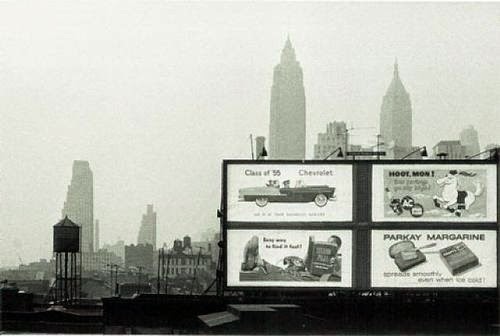William Klein nato a New York nel
1928 da una famiglia ebrea di origine ungherese, all’età di 18 anni passa due
anni nell’esercito d’occupazione e si stabilisce poi a Parigi per diventare
pittore. Nel 1954 torna a New York e lavora a una sorta di diario fotografico
che uscirà due anni dopo in un volume disegnato dallo stesso autore, Life is
Good & Good for You in New York, che gli varrà il premio Nadar. Raggiunge
Fellini a Roma per fargli da assistente. Alla fine degli anni ’50 si avvicina
al cinema al quale si dedicherà in maniera esclusiva per alcuni anni
realizzando diversi film. Negli anni ’80 torna alla fotografia e pubblica
numerosi libri. Il suo lavoro viene esposto in tutto il mondo e riceve molti
premi e riconoscimenti. Innumerevoli i lavori, i libri, i progetti realizzati
da questo poliedrico e instancabile artista. Nel 2008 pubblica il volume
Contacts edito da Contrasto, che accompagna la mostra omonima.
William
Klein was a sculptor who grew up in New York and went to work in Fernand
Leger's Paris studio. He became interested in photography to record movement in
his sculpture and started using a camera. He was soon photographing other
things that took his interest, and in 1954 his work was seen by American Vogue
art director (and another sculptor) Alexander Liberman, who offered him a
contract as a fashion photographer.
Liberman
saw in his work a fresh approach, and one that seemed to have a certain
violence that would move the magazine away from the 'polite' images of Cecil
Beaton. Because Klein did not know how to use a studio, took the models out
onto the streets to photograph. Later he pioneered the use of wide angle and
telephoto lenses for fashion work.
Klein's
photoreportage style involved a rejection of the by now classic idea of the
photographer as a 'fly on the wall', an unseen recorder of events. Klein
recognized and through his methods emphasized the interaction between
photographer and subject, often almost pushing his camera with wide angle lens
into peoples faces.
He
went on to produce a book, New York, New York (1956) which featured this quick
reflex 35mm street photography with a graphic design and text which owed
something to both the New York Daily News and cheap advertising. This was
followed by later books on Rome (1960), Moscow (1964) and Tokyo (1964).
Klein
also made a number of movies, starting with one of the first Pop films,
Broadway by Light; in 1962 he gave up still photography (except for a few
fashion pictures for Vogue) to produce films on Muhammed Ali and Little
Richard, the Vietnam War, and experimental films 'Mr Freedom' and 'Qui-Etes
Vous Polly Magoo', which satirises Vogue.
Around 1980, Klein returned to
still photography, mainly photographing people in crowd situations using an
extreme wide angle lens.
All
images © William Klein
























Nessun commento:
Posta un commento